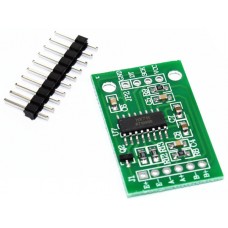|
Electronic board based on the HX711 chip, a 24-bit analog-to-digital converter, specifically designed to interface the load cell to a microcontroller such as Arduino, Fishino or compatible. The input multiplexer selects either Channel A or B differential input to the low-noise programmable gain amplifier (PGA). Dimensions (mm): 33.6x20.5x3.
Warning! Arduino, Fishino and the load cell are not included (see related products).
|
| |
| Features of the HX711 chip |
- Two selectable differential input channels
- On-chip active low noise PGA with selectable gain of 32, 64 and 128
- On-chip power supply regulator for load-cell and ADC analog power supply
- On-chip oscillator requiring no external component with optional external crystal
- On-chip power-on-reset
- Simple digital control and serial interface: pin-driven controls, no programming needed
- Selectable 10SPS or 80SPS output data rate
- Simultaneous 50 and 60Hz supply rejection
- Current consumption including on-chip analog power supply regulator: normal operation < 1.5mA, power down < 1uA
- Operation supply voltage range: 2.6 ~ 5.5V
- Operation temperature range: -40°C ~ +85℃
- 16 pin SOP-16 package
|
 |
| |
| Application with Arduino and HX711 board (not included) |
| |
 |
|
#include “HX711.h”
#define calibration_factor -9580.00 //This value is obtained using the SparkFun_HX711_Calibration sketch
#define DOUT 4
#define CLK 5
HX711 scale(DOUT, CLK);
void setup() {
Serial.begin(9600);
Serial.println(“HX711 scale demo”);
scale.set_scale(calibration_factor);
scale.tare(); //Assuming there is no weight on the scale at start up, reset the scale to 0
Serial.println(“Readings:”);
}
void loop() {
Serial.print(“Reading: “);
float libbre = scale.get_units();
float kg = (libbre/2.2046);
Serial.print(kg, 1); //scale.get_units() returns a float
Serial.print(” kg”); //You can change this to kg but you’ll need to refactor the calibration_factor
Serial.println();
}
|
| |
|
Download and recommended links
|
| |
|
|








